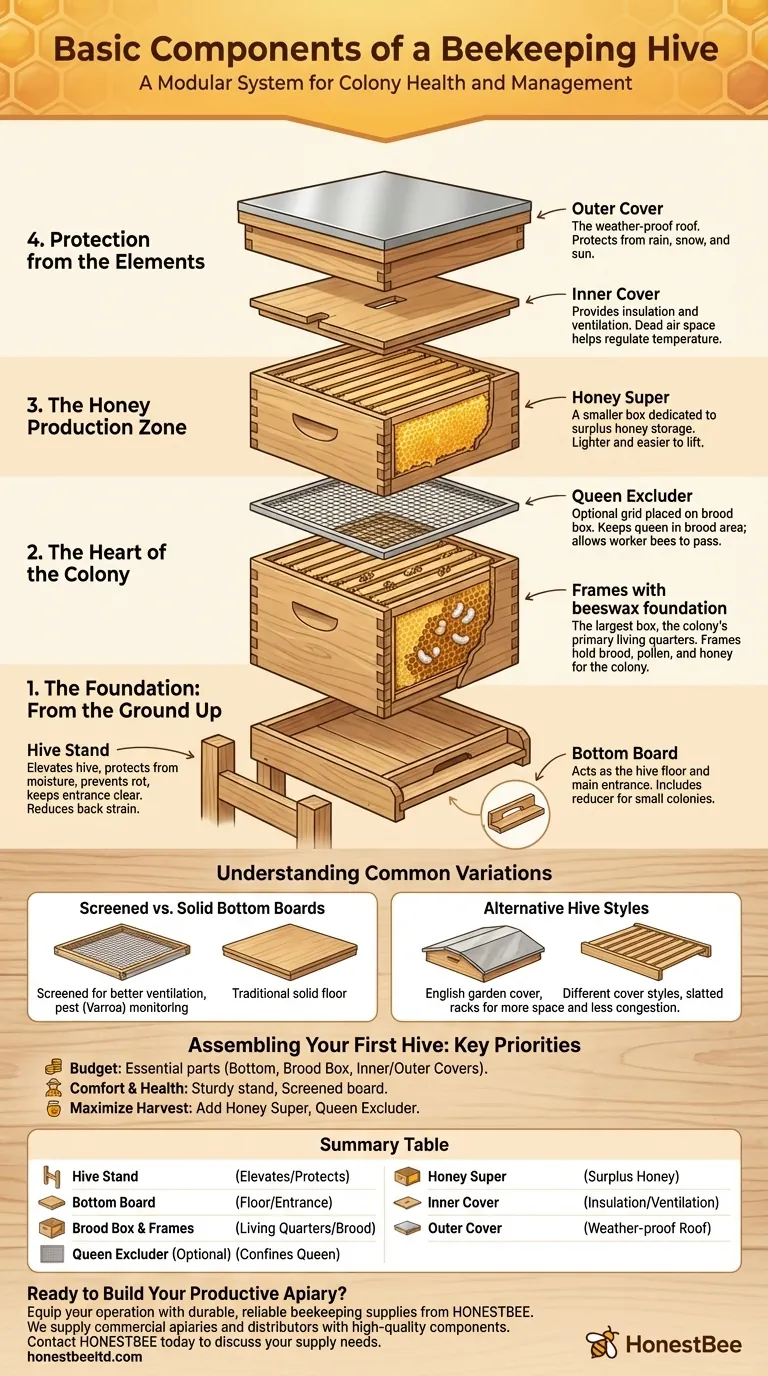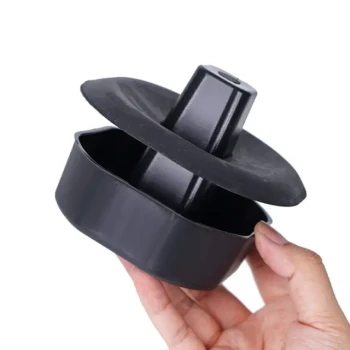At its core, a modern beehive is a modular system consisting of a hive stand, bottom board, one or more hive bodies filled with frames, an inner cover, and an outer cover. These components work together to provide a secure, expandable home for the honeybee colony while allowing the beekeeper to manage them and harvest honey.
A beehive is not just a box; it's a carefully designed environment. Understanding the specific function of each component is the first step toward successfully managing a healthy and productive colony.

The Foundation: From the Ground Up
Every strong structure starts with a solid base. For a beehive, this means elevating it off the ground and providing a stable floor and entrance.
The Hive Stand
A hive stand is the foundation that lifts the entire hive off the ground. This elevation is critical for several reasons.
It protects the wooden bottom board from ground moisture, preventing rot and decay. It also keeps the hive entrance clear of grass and debris, ensuring the bees have an unobstructed flight path.
Finally, raising the hive to a comfortable working height reduces back strain for the beekeeper during inspections.
The Bottom Board
The bottom board serves as the floor of the hive. It also features an entrance at the front, which the bees use to come and go.
This component often includes a wooden reducer that can be used to shrink the size of the entrance, which helps a new or small colony defend itself from intruders.
The Heart of the Colony
This is the central living area of the hive, where the queen lays her eggs and the colony raises the next generation of bees.
The Brood Box and Frames
The brood box (or "hive body") is the largest box in the stack. It's the primary living quarters for the colony.
Inside the brood box hang frames, which are typically filled with a foundation of beeswax or plastic. The bees use these frames to build out honeycomb for raising brood (eggs, larvae, and pupae) and storing pollen and honey for their own consumption.
The Queen Excluder (Optional)
A queen excluder is a flat metal or plastic grid placed on top of the brood box. The openings are large enough for worker bees to pass through but too small for the larger queen.
Its sole purpose is to keep the queen confined to the brood box, ensuring she only lays eggs there. This keeps the upper boxes, or honey supers, dedicated exclusively to honey storage.
The Honey Production Zone
This section is dedicated to the surplus honey that the beekeeper can harvest.
The Honey Super
A honey super is a smaller box, identical in function to the brood box, that is placed on top of the queen excluder.
Because the queen cannot access this area, the bees use it exclusively for storing surplus honey. Using shallower boxes for honey makes them much lighter and easier to lift when they are full.
Protection from the Elements
The top layers of the hive are designed to provide insulation, ventilation, and protection from weather.
The Inner Cover
The inner cover sits directly on top of the uppermost honey super. It creates a dead air space that provides insulation, helping the bees regulate the hive's internal temperature.
It also has a notch or hole in the center, which can be used for ventilation or as an upper entrance.
The Outer Cover
The outer cover is the final piece of the hive, acting as its roof. It is typically made of wood and covered with a layer of metal to protect the hive from rain, snow, and sun.
It telescopes down over the top of the hive, providing a weather-tight seal that keeps the colony safe and dry.
Understanding Common Variations
While the components listed above form a standard Langstroth hive, beekeeping allows for customization based on your climate, goals, and management style.
Screened vs. Solid Bottom Boards
Some beekeepers prefer a screened bottom board over a solid one. This design replaces the wooden floor with a heavy-duty mesh screen, which provides superior ventilation and helps in monitoring for Varroa mites, a common honeybee pest.
Alternative Hive Styles
Not every hive looks the same. Some beekeepers use different cover styles, like an English garden cover, for aesthetic reasons. Others might add a slatted rack between the bottom board and the brood box to give the bees more clustering space and reduce entrance congestion.
Assembling Your First Hive: Key Priorities
Your initial setup should be guided by your specific goals as a new beekeeper.
- If your primary focus is starting on a budget: Begin with the absolute essentials: a bottom board, one brood box with frames, an inner cover, and an outer cover.
- If your primary focus is beekeeper comfort and hive health: Invest in a sturdy hive stand and consider a screened bottom board for better ventilation and pest management.
- If your primary focus is maximizing honey harvest: Ensure you have at least one honey super and a queen excluder ready to add when the colony grows strong.
By understanding how these simple parts create a functional whole, you are well-equipped to build a thriving home for your bees.
Summary Table:
| Component | Primary Function |
|---|---|
| Hive Stand | Elevates hive, protects from moisture, reduces back strain. |
| Bottom Board | Acts as the hive floor; includes the main entrance. |
| Brood Box & Frames | The colony's living quarters for raising brood and storing food. |
| Queen Excluder (Optional) | Keeps the queen in the brood area to separate honey storage. |
| Honey Super | Shallower box where bees store surplus honey for harvest. |
| Inner Cover | Provides insulation and ventilation for the hive. |
| Outer Cover | The weather-proof roof that protects the colony from the elements. |
Ready to Build Your Productive Apiary?
Equip your operation with durable, reliable beekeeping supplies from HONESTBEE. We supply commercial apiaries and equipment distributors with the high-quality components needed for success. From sturdy hive stands to efficient honey supers, our wholesale-focused operations ensure you get the gear that supports healthy, productive colonies.
Contact HONESTBEE today to discuss your supply needs and build a stronger foundation for your beekeeping business.
Visual Guide

Related Products
- Professional Ant-Proof Beehive Stand with Integrated Moat for Beekeeping
- Professional Galvanized Hive Strap with Secure Locking Buckle for Beekeeping
- Versatile Ratchet Hive Strap with S-Hooks for Secure Fastening
- Automatic Honey Flow Beehive 4 Frame Mini Hive for Beekeeping
- Endless Loop Ratchet Hive Strap
People Also Ask
- How high should my beehive be off the ground? Optimize for Pests, Health & Ergonomics
- What are the primary functions of a hive stand in beekeeping? Essential for Colony Health & Beekeeper Comfort
- What is the function of a hive stand in a beehive? Protect Your Hive and Your Back
- Why is it important to keep a beehive dry? Ensure Colony Health and Hive Longevity
- What should I put my beehive on? A Guide to Hive Stands and Location for a Healthy Colony



















